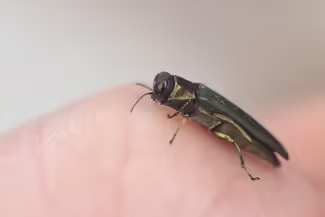
URBANA, Ill. — While much of Illinois has been focused on the emergence of periodical cicadas in the summer of 2024, another insect is buzzing about that is more than a nuisance; it’s a threat to ash trees everywhere. In June, the small metallic green adult emerald ash borers are flying around looking for ash trees to lay their eggs in. But you may not always see them because they spend most of their time in the upper canopy of ash trees. Once hatched, the larvae will tunnel around under the bark, eventually killing the tree.
University of Illinois Extension staff have been monitoring the spread and impact of the invasive emerald ash borer since it first arrived in the Chicago area in 2006 and are available to help homeowners and municipalities identify infestations and decide on a course of action. While northern and central parts of the state have already experienced the initial wave of ash tree deaths from infestations, Foresty Extension and Research Specialist Chris Evans says 14 years after the beetle's arrival, trees in southern and western Illinois are still being affected.
“The loss of so many ash trees over the last 10 to 15 years due to the emerald ash borer has already changed so much about the landscape across the Midwest, in both cities and forests,” said Evans. “The death of mature ash trees has left a void in our forests, parks, and backyards, and it is still spreading across Illinois. Now is the time of year when the leaves are fully developed for the summer, and you can see the impact on ash trees that have thinning canopy and branches that have died back.”
The emerald ash borer (Agrilus planipennis) is an invasive beetle responsible for the death of an estimated 250 million ash trees across North America. Ash trees make up 20% to 50% of the urban forest in some cities, and their loss impacts property values, human health, home energy costs, and much more. In forests, the loss of ash trees makes the ecosystem more vulnerable to other invasive species, reduces food and habitat for wildlife, and prevents timber harvest.
Emerald ash borer larvae eat a thin layer of tissue under the bark, and the resulting labyrinth of tunnels prevents the tree from absorbing nutrients and water. Most infested trees die in two to five years. The beetle is a weak flyer, so the insect’s rapid spread in the U.S. since its arrival in Michigan in 2002 is tied to people transporting them by moving logs and firewood.
Signs of an emerald ash borer infestation include dieback on the top of an ash tree and many small leafy shoots sprouting from the trunk. Woodpeckers often feed on the larvae and leave ragged holes and broken pieces of bark. Another sign is the presence of D-shaped exit holes in the tree trunk that adults leave when they emerge.
Efforts are underway to breed trees that are resistant to the insects and to release wasps that are natural predators of the beetles. A common treatment option is the application of insecticide, either annually or every two to three years. This does not fully remove the insects, but it does protect the tree from a large, potentially fatal infestation. Often, the most cost-effective management option is to remove a tree.
Homeowners and municipalities can connect with their local Illinois Extension offices at go.illinois.edu/ExtensionOffice for consultations to help identify ash trees and emerald ash borer infestations, and to discuss options. Extension also has a free online course for homeowners and municipalities that covers ash tree identification, the life cycle of the emerald ash borer, signs of an infested tree, and treatment or removal options. The course is available in English at go.illinois.edu/EABCourse and in Spanish at go.illinois.edu/BEFcurso. More information about the emerald ash borer is also available on Extension’s website at go.illinois.edu/EAB.
The Extension forestry team conducts research projects, maintains demonstration sites, and teaches courses at University of Illinois. They also administer the Illinois Big Tree Program and the new Citizen Big Tree Inspector initiative. The program is part of the university’s department of natural resources and environmental sciences. Explore more about Extension forestry resources at extension.illinois.edu/forestry.
Illinois Extension leads public outreach for University of Illinois by translating research into action plans that allow Illinois families, businesses, and community leaders to solve problems, make informed decisions, and adapt to changes and opportunities. Illinois Extension is part of the University of Illinois Urbana-Champaign College of Agricultural, Consumer and Environmental Sciences.


